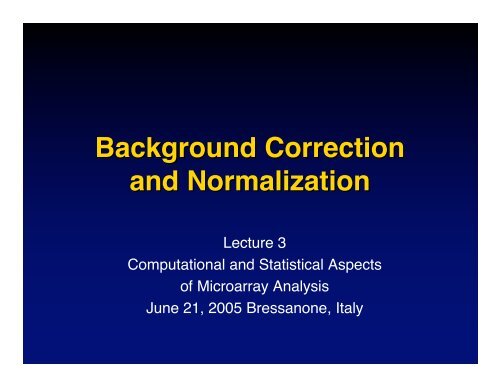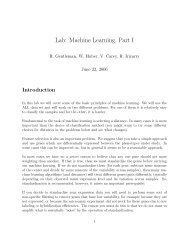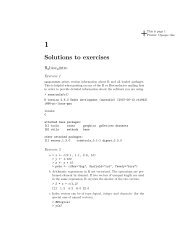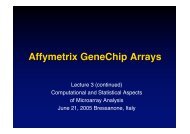Background Correction and Normalization - Computational Statistics ...
Background Correction and Normalization - Computational Statistics ...
Background Correction and Normalization - Computational Statistics ...
You also want an ePaper? Increase the reach of your titles
YUMPU automatically turns print PDFs into web optimized ePapers that Google loves.
<strong>Background</strong> <strong>Correction</strong><br />
<strong>and</strong> <strong>Normalization</strong><br />
Lecture 3<br />
<strong>Computational</strong> <strong>and</strong> Statistical Aspects<br />
of Microarray Analysis<br />
June 21, 2005 Bressanone, Italy
Feature Level Data
Outline<br />
• Affymetrix GeneChip arrays<br />
• Two color platforms
Affymetrix GeneChip Design<br />
5’ 3’<br />
Reference sequence<br />
…TGTGATGGTGCATGATGGGTCAGAAGGCCTCCGATGCGCCGATTGAGAAT…<br />
GTACTACCCAGTCTTCCGGAGGCTA Perfectmatch<br />
GTACTACCCAGTGTTCCGGAGGCTA Mismatch<br />
NSB & SB<br />
NSB
Before Hybridization<br />
Sample 1 Sample 2<br />
Array 1 Array 2
More Realistic<br />
Sample 1 Sample 2<br />
Array 1 Array 2
Non-specific Hybridization<br />
Array 1 Array 2
Affymetrix GeneChip Design<br />
5’ 3’<br />
Reference sequence<br />
…TGTGATGGTGCATGATGGGTCAGAAGGCCTCCGATGCGCCGATTGAGAAT…<br />
GTACTACCCAGTCTTCCGGAGGCTA Perfectmatch (PM)<br />
GTACTACCCAGTGTTCCGGAGGCTA Mismatch (MM)<br />
NSB & SB<br />
NSB
GeneChip Feature Level Data<br />
• MM features used to measure optical noise <strong>and</strong> nonspecific<br />
binding directly<br />
• More than 10,000 probesets<br />
• Each probeset represented by 11-20 feature Note 1: Position<br />
of features are haphazardly distributed about the array.<br />
Note 2: There are between 20-100 chip types<br />
• So we have PM gij , MM gij<br />
(g is gene, i is array <strong>and</strong> j is feature)<br />
• A default summary is the avg of the PM-MM
Two color platforms<br />
• Common to have just one feature per gene<br />
• Typically, longer molecules are used so nonspecific<br />
binding not so much of a worry<br />
• Optical noise still a concern<br />
• After spots are identified, a measure of local<br />
background is obtained from area around spot
Local background<br />
---- GenePix<br />
---- QuantArray<br />
---- ScanAnalyze
Two color feature level data<br />
• Red <strong>and</strong> Green foreground <strong>and</strong> <strong>and</strong><br />
background obtained from each feature<br />
• We have Rf gij , Gf gij , Rb gij , Gb gij (g is gene, i is<br />
array <strong>and</strong> j is replicate)<br />
•<br />
• A default summary statistic is the log-ratio:<br />
(Rf-Rb) / (Gf - Gb)
Affymetrix Spike In<br />
Experiment
Spike-in Experiment<br />
• Throughout we will be using Data from Affymetrix’s<br />
spike-in experiment<br />
• Replicate RNA was hybridized to various arrays<br />
• Some probesets were spiked in at different<br />
concentrations across the different arrays<br />
• This gives us a way to assess precision <strong>and</strong> accuracy<br />
• Done for HGU95 <strong>and</strong> HGU133 chips
Spikein Experiment (HG-U95)<br />
Probeset<br />
A<br />
r<br />
r<br />
a<br />
y<br />
1 2 3 4 5 6 7 8 9 10 11 12 13 14 15 16<br />
A 0 0.25 0.5 1 2 4 8 16 32 64 128 0 512 1024 256 32<br />
B 0.25 0.5 1 2 4 8 16 32 64 128 256 0.25 1024 0 512 64<br />
C 0.5 1 2 4 8 16 32 64 128 256 512 0.5 0 0.25 1024 128<br />
D 1 2 4 8 16 32 64 128 256 512 1024 1 0.25 0.5 0 256<br />
E 2 4 8 16 32 64 128 256 512 1024 0 2 0.5 1 0.25 512<br />
F 4 8 16 32 64 128 256 512 1024 0 0.25 4 1 2 0.5 1024<br />
G 8 16 32 64 128 256 512 1024 0 0.25 0.5 8 2 4 1 0<br />
H 16 32 64 128 256 512 1024 0 0.25 0.5 1 16 4 8 2 0.25<br />
I 32 64 128 256 512 1024 0 0.25 0.5 1 2 32 8 16 4 0.5<br />
J 64 128 256 512 1024 0 0.25 0.5 1 2 4 64 16 32 8 1<br />
K 128 256 512 1024 0 0.25 0.5 1 2 4 8 128 32 64 16 2<br />
L 256 512 1024 0 0.25 0.5 1 2 4 8 16 256 64 128 32 4<br />
M 512 1024 0 0.25 0.5 1 2 4 8 16 32 512 128 256 64 8<br />
N 512 1024 0 0.25 0.5 1 2 4 8 16 32 512 128 256 64 8<br />
O 512 1024 0 0.25 0.5 1 2 4 8 16 32 512 128 256 64 8<br />
P 512 1024 0 0.25 0.5 1 2 4 8 16 32 512 128 256 64 8<br />
Q 1024 0 0.25 0.5 1 2 4 8 16 32 64 1024 256 512 128 16<br />
R 1024 0 0.25 0.5 1 2 4 8 16 32 64 1024 256 512 128 16<br />
S 1024 0 0.25 0.5 1 2 4 8 16 32 64 1024 256 512 128 16<br />
T 1024 0 0.25 0.5 1 2 4 8 16 32 64 1024 256 512 128 16
Spikein Experiment (HG-U133)<br />
• A similar experiment was repeated for a newer<br />
chip<br />
• The 1024 picoMolar concentration was not<br />
used. 1/8 was used instead.<br />
• No groups of 12<br />
• Note: More spike-ins to come!
Introduction to<br />
Preprocessing
Composition of Feature Intensities<br />
• Specific binding<br />
• Non-specific binding <strong>and</strong> Optical noise<br />
• Systematic variations<br />
• Stochastic noise<br />
• We will focus on Affymetrix GeneChip<br />
first
Three main steps<br />
• <strong>Background</strong> adjustment of correction<br />
• <strong>Normalization</strong><br />
• Summarization
Why is it difficult?<br />
These are from replicate RNA. Left are empirical density<br />
estimates for 5 GeneChip arrays. Right is MA plot for one two-color array
Approaches<br />
• Stepwise: The most common approach is to solve<br />
these issues one by one <strong>and</strong> produce one<br />
measurement of expression (absolute or relative) for<br />
each gene<br />
– Typically the order is: correct for background, normalize, then<br />
summarize.<br />
• Integrated: Statistical models that quantify the need<br />
for normalization as well as the amount of expression<br />
are used
<strong>Background</strong> Noise
Distribution of Optical <strong>and</strong> NSB Noise<br />
Note: Material in this lecture are for Affymetrix Arrays
Effect on Data<br />
Concentration of 0 pM<br />
Concentration of 0.5 pM<br />
100 100<br />
Concentration of 1.0 pM<br />
100
Spike-In Data<br />
• Specific Binding:<br />
Linear with<br />
concentration<br />
• <strong>Background</strong><br />
Additive<br />
Y=B+aC
Effect of <strong>Background</strong><br />
B + aC 1<br />
B + aC 2<br />
≠ C 1<br />
C 2<br />
log(B + aC 1<br />
) − log(B + aC 2<br />
) ≠ log(C 1<br />
) − log(C 2<br />
)<br />
log(B + aC) ≈ log(B)<br />
When a or C is small
Why background correct
Different NSB for different features<br />
Therobe Effect
Direct Measurement Strategy<br />
• Affymetrix’s tries to measure nonspecific<br />
binding directly<br />
• PM-MM is supposed to give us a good<br />
estimate of specific binding<br />
• But it is not so simple
Sometimes MM larger then PM
Deterministic Model<br />
PM = O + N + S<br />
MM = O + N<br />
PM – MM = S<br />
For reasons explained later, we<br />
want to take log of S
Deterministic model is wrong<br />
• Do MM measure nonspecific<br />
binding?<br />
• Look at Yeast DNA<br />
hybridized to Human<br />
Chip<br />
• Look at PM, MM logscale<br />
scatter-plot<br />
• R 2 is only 0.5
Stochastic Model<br />
(Additive background/multiplicative error)<br />
PM = O PM + N PM + S,<br />
MM = O MM + N MM<br />
log (N PM ), log (N MM ) ~ Bivariate Normal (ρ ≈ 0.7)<br />
S = exp ( s + a + ε )<br />
s is the quantity of interest (log scale expression)<br />
E[ PM – MM ] = S , but<br />
Var[ log( PM – MM ) ] ~ 1/S 2 (can be very large)<br />
Note: Technically, var[ log(PM-MM) ] is not defined. We need to make sure<br />
we avoid taking logs of negative. Affymetrix’s current default does this.
Simulation<br />
• We create some feature level data for two replicate<br />
arrays<br />
• Then compute Y=log(PM-kMM) for each array<br />
• We make an MA using the Ys for each array<br />
• We make a observed concentration versue known<br />
concentration plot<br />
• We do this for various values of k. The following<br />
“movie” shows k moving from 0 to 1.
Does this happen in practice?<br />
MAS 5.0<br />
RMA
RMA: The Basic Idea<br />
Observed: PM<br />
Of interest: S<br />
PM=B+S<br />
Pose a statistical model <strong>and</strong> use it<br />
to predict S from the observed PM
The Basic Idea<br />
PM=B+S<br />
• A mathematically convenient, useful<br />
model<br />
– B ~ Normal (µ,σ)<br />
S ~ Exponential (λ)<br />
S ˆ =<br />
E[ S<br />
|<br />
PM<br />
– No MM<br />
– Borrowing strength across probes<br />
]
<strong>Normalization</strong>
<strong>Normalization</strong><br />
• <strong>Normalization</strong> is needed to ensure that differences in<br />
intensities are indeed due to differential expression,<br />
<strong>and</strong> not some printing, hybridization, or scanning<br />
artifact.<br />
• <strong>Normalization</strong> is necessary before any analysis<br />
which involves within or between slides<br />
comparisons of intensities, e.g., clustering, testing.<br />
• <strong>Normalization</strong> is different in spotted/two-color <strong>and</strong><br />
high-density-oligonucleotides (Affy) technologies
Outline<br />
• Why do we need to normalize<br />
• Types of normalization<br />
– Affy<br />
– cDNA<br />
• Case study<br />
• Discussion
Technical Replicates<br />
Different scanners where used! These is Affymetrix data
Empirical Densities for Replicates<br />
Compliments of Ben Bolstad
Self-self hybridization<br />
log 2 R vs. log 2 G
Self-self hybridization<br />
M vs. A<br />
Two-color platform
Self-self hybridization<br />
M vs. A<br />
Robust local regression<br />
within sectors<br />
(print-tip-groups)<br />
of intensity log-ratio M<br />
on average log-intensity<br />
A.
Intensity<br />
log-ratio, M<br />
Boxplots by print-tip-group
What can we do?<br />
• Throw away the data <strong>and</strong> start again? Maybe.<br />
• <strong>Statistics</strong> offers hope:<br />
– Use control genes to adjust<br />
– Assume most genes are not differentially<br />
expressed<br />
– Assume distribution of expression are the<br />
same
Simplest Idea<br />
• Assume all arrays have the same median log expression or relative log<br />
expression<br />
• Subtract median from each array<br />
• In two-color platforms, we typically correct the Ms. Median correction<br />
forces the median log ratio to be 0<br />
– Note: We assume there are as many over-expressed as underexpressed<br />
genes)<br />
• For Affymetrix arrays we usually add a constant that takes us back to<br />
the original range.<br />
– It is common to use the median of the medians<br />
– Typically, we subtract in the log-scale
How does it work<br />
Notice subtracting in the original scale wont work well
How does it work<br />
The medians match but there are some discrepancies
What are the consequences<br />
These are two technical replicates. Only the red are differentially expressed
There appears to be a non-linear<br />
dependence on intensity<br />
• Proposed solutions<br />
– Force distributions (not just medians) to be the same:<br />
• Amaratunga <strong>and</strong> Cabrera (2001)<br />
• Bolstad et al. (2003)<br />
– Use curve estimators such as splines to adjust for the effect:<br />
• Li <strong>and</strong> Wong (2001) Note: they also use a rank invariant set<br />
• Colantuoni et al (2002)<br />
• Dudoit et al (2002)<br />
– Use adjustments based on additive/multiplicative model:<br />
• Rocke <strong>and</strong> Durbin (2003)<br />
• Huber et al (2002)<br />
• Cui et al (2003)
Quantile normalization<br />
• All these non-linear methods perform<br />
similarly<br />
• Quantiles is my favorite because its fast<br />
• Basic idea:<br />
– order value in each array<br />
– take average across probes<br />
– Substitute probe intensity with average<br />
– Put in original order
Example of quantile normalization<br />
Original Ordered Averaged Re-ordered<br />
2<br />
4<br />
4<br />
2<br />
3<br />
4<br />
3<br />
3<br />
3<br />
3<br />
5<br />
3<br />
5<br />
4<br />
14<br />
3<br />
4<br />
8<br />
5<br />
5<br />
5<br />
8<br />
5<br />
8<br />
4<br />
6<br />
8<br />
3<br />
4<br />
8<br />
5<br />
5<br />
5<br />
6<br />
8<br />
5<br />
3<br />
5<br />
8<br />
4<br />
5<br />
9<br />
6<br />
6<br />
6<br />
5<br />
6<br />
5<br />
3<br />
3<br />
9<br />
5<br />
6<br />
14<br />
8<br />
8<br />
8<br />
5<br />
3<br />
6
How does it work
How does it work<br />
Does it wash away real differential expression?
Before <strong>and</strong><br />
These are two technical replicates. Only the red are differentially expressed
After quantile normalization<br />
We say more later…..
Two-color platforms<br />
• Identify <strong>and</strong> remove the effects of systematic variation<br />
in the measured fluorescence intensities, other than<br />
differential expression, for example<br />
– different labelling efficiencies of the dyes;<br />
– different amounts of Cy3- <strong>and</strong> Cy5-labelled mRNA;<br />
– different scanning parameters;<br />
– print-tip, spatial, or plate effects, etc.
<strong>Normalization</strong><br />
• Much more complicated than Affy<br />
• The need for normalization can be seen most clearly<br />
in self-self hybridizations, where the same mRNA<br />
sample is labeled with the Cy3 <strong>and</strong> Cy5 dyes.<br />
• The imbalance in the red <strong>and</strong> green intensities is<br />
usually not constant across the spots within <strong>and</strong><br />
between arrays, <strong>and</strong> can vary according to overall<br />
spot intensity, location, plate origin, etc.<br />
• These factors should be considered in the<br />
normalization.
MA-plot by print-tip-group<br />
Intensity<br />
log ratio, M<br />
The smooth<br />
curves were<br />
created using<br />
loess. Splines<br />
work just as well<br />
Average<br />
log intensity, A
Example of <strong>Normalization</strong><br />
log 2 R/G log 2 R/G – L(intensity, sector, …)<br />
• Constant normalization: L is constant<br />
• Adaptive normalization: L depends on a number<br />
of predictor variables, such as spot intensity<br />
A, sector, plate origin.<br />
– Intensity-dependent normalization.<br />
– Intensity <strong>and</strong> sector-dependent normalization.<br />
– 2D spatial normalization.<br />
– Other variables: time of printing, plate, etc.<br />
– Composite normalization. Weighted average of<br />
several normalization functions.
2D images of L values<br />
Global median<br />
normalization<br />
Global loess<br />
normalization<br />
Within-print-tipgroup<br />
loess<br />
normalization<br />
2D spatial<br />
normalization
2D images of normalized M-L<br />
Global median<br />
normalization<br />
Global loess<br />
normalization<br />
Within-print-tipgroup<br />
loess<br />
normalization<br />
2D spatial<br />
normalization
Boxplots of normalized M-L<br />
Global median<br />
normalization<br />
Global loess<br />
normalization<br />
Within-print-tipgroup<br />
loess<br />
normalization<br />
2D spatial<br />
normalization
MA-plots of normalized M-L<br />
Global median<br />
normalization<br />
Global loess<br />
normalization<br />
Within-print-tipgroup<br />
loess<br />
normalization<br />
2D spatial<br />
normalization
Comparison to other methods<br />
MSP<br />
Rank invariant<br />
Housekeeping<br />
Tubulin, GAPDH
What if we know most genes are<br />
up <strong>and</strong> down regulated?<br />
• Then it will be hard to normalize<br />
• Let us look at an example
Dilution Experiment<br />
• cRNA hybridized to human chip (HGU95) in range<br />
of proportions <strong>and</strong> dilutions<br />
• Dilution series begins at 1.25 µg cRNA per<br />
GeneChip array, <strong>and</strong> rises through 2.5, 5.0, 7.5,<br />
10.0, to 20.0 µg per array. 5 replicate chips were<br />
used at each dilution<br />
• A few control genes were spiked in at same<br />
concentration across all arrays.<br />
• Notice we can only make usual assumption within<br />
groups of 5
Raw Data
If you can’t t normalized your conclusions<br />
will likely be wrong!
Normalize with control genes<br />
Looks almost as bad!
We can not median normalize<br />
We wash out real biological effects
Or quantile normalize
But we can quantile normalize<br />
<strong>and</strong> then use controls
Look at the improvement
Look at the improvement
Method<br />
Med<br />
slope<br />
Log<br />
SD<br />
Std %<br />
change<br />
Raw<br />
0.39<br />
0.35<br />
27%<br />
Controls<br />
0.52<br />
0.25<br />
19%<br />
Median<br />
-0.01<br />
0.17<br />
12%<br />
Quantiles<br />
0.00<br />
0.14<br />
10%<br />
Quantiles/ctrls<br />
0.55<br />
0.14<br />
10%
Why the non-linear dependence?<br />
• The additive background noise plus<br />
multiplicative error models predicts<br />
these non-linear behavior.<br />
• The multiplicative part explains the<br />
difference in over-all mean log-intensity<br />
• Different background noise mean levels<br />
causes non-linear MA plots
Add a different constant
Add noise with different mean
Conclusions<br />
• I still haven’t seen microarry data that doesn’t need to<br />
be normalized<br />
• Non-linear methods are better than linear ones<br />
• If you can’t assume most genes are not differentially<br />
expressed or that probe intensities have roughly the<br />
same distribution you need many control genes<br />
(hundreds maybe thous<strong>and</strong>s)<br />
• Control genes must cover the dynamic range








